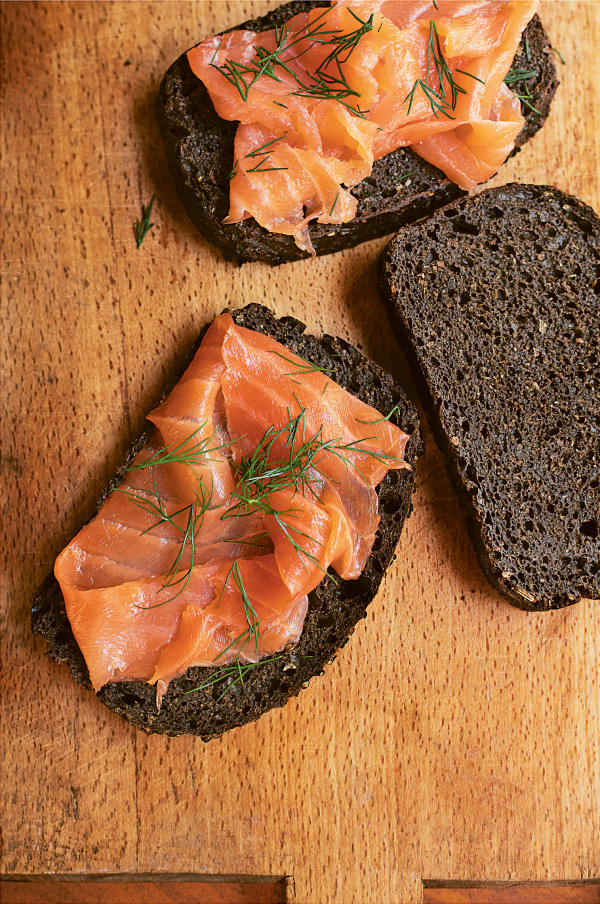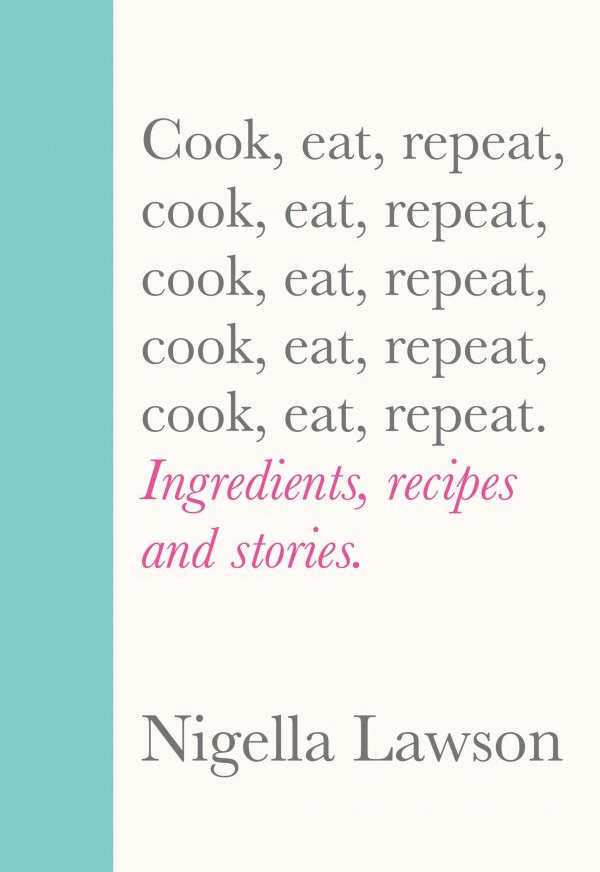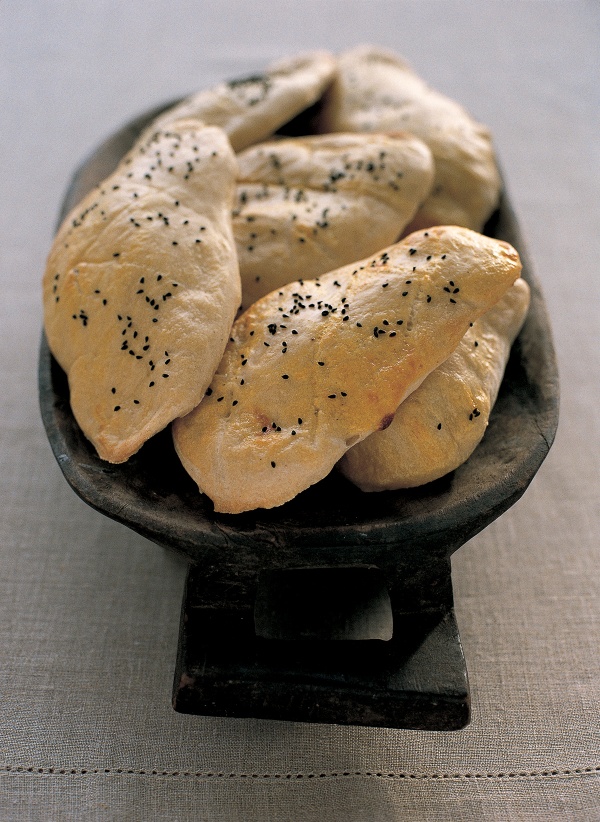No-Knead Black Bread
by Nigella. Featured in COOK EAT REPEATIntroduction
I love proper Eastern European black bread, but I must confess that this loaf, although it tastes the part, is hardly traditional, let alone authentic. For one thing, it’s made following the no-knead method, and for another it contains stout — its ferrous tang partnered by black treacle and mellowed by dark muscovado sugar — which makes this recipe something of a louche aberration. But it’s so easy to make, and so wonderful to eat, I don’t think we can let that concern us.
The only thing you must be prepared for is that you do need to start making it a full day before you want to eat it, not because it’s elaborate in any way, but just because it requires, all told, about a day's rising (during which time you can happily ignore it). And while I can’t imagine anyone not loving this, I do know that there are those who regard anything in the anise arena with antagonism; I’m afraid to say, however, that it just doesn’t taste right without the caraway and fennel seeds.
As there is an egg white in the dough and the top is painted with a egg wash made with the leftover yolk it isn’t vegan-friendly, but that can easily be remedied: simply replace the egg white with 1 teaspoon of vegan egg-replacer powder, adding it along with the dried ingredients, and instead of the yolk wash, glaze the loaf with 1 teaspoon of maple syrup mixed into 2 teaspoons of almond milk, although you won’t get the high shine you get with egg wash. There’s no need, by the way, to rush out to get activated charcoal: it doesn’t affect the taste, but simply makes the loaf a deeper hue. But whatever you do, don’t be tempted to use what’s sold as “black cocoa”; just trust me on this!
It’s good with so much: cream cheese, cherry jam — or cream cheese and cherry jam! — smoked fish of any sort, ditto cured meat, and I just adore it with taramasalata, And it’s spirit-lifitingly gorgeous when spread with the almost fluo pink of Beetroot and Chickpea Dip which is, in effect, beetroot hummus, just as it is, or topped with slices of avocado and a few fronds of dill.
Finally, although I don’t as a rule go in for starters before Christmas lunch, I can testify that a few slices of this dark beauty topped with smoked salmon, a squeeze of lemon, and - if you can get it - some fresh horseradish, grated on top, along with a little dill, is just perfect with pre-Christmas-Dinner drinks.
I love proper Eastern European black bread, but I must confess that this loaf, although it tastes the part, is hardly traditional, let alone authentic. For one thing, it’s made following the no-knead method, and for another it contains stout — its ferrous tang partnered by black treacle and mellowed by dark muscovado sugar — which makes this recipe something of a louche aberration. But it’s so easy to make, and so wonderful to eat, I don’t think we can let that concern us.
The only thing you must be prepared for is that you do need to start making it a full day before you want to eat it, not because it’s elaborate in any way, but just because it requires, all told, about a day's rising (during which time you can happily ignore it). And while I can’t imagine anyone not loving this, I do know that there are those who regard anything in the anise arena with antagonism; I’m afraid to say, however, that it just doesn’t taste right without the caraway and fennel seeds.
As there is an egg white in the dough and the top is painted with a egg wash made with the leftover yolk it isn’t vegan-friendly, but that can easily be remedied: simply replace the egg white with 1 teaspoon of vegan egg-replacer powder, adding it along with the dried ingredients, and instead of the yolk wash, glaze the loaf with 1 teaspoon of maple syrup mixed into 2 teaspoons of almond milk, although you won’t get the high shine you get with egg wash. There’s no need, by the way, to rush out to get activated charcoal: it doesn’t affect the taste, but simply makes the loaf a deeper hue. But whatever you do, don’t be tempted to use what’s sold as “black cocoa”; just trust me on this!
It’s good with so much: cream cheese, cherry jam — or cream cheese and cherry jam! — smoked fish of any sort, ditto cured meat, and I just adore it with taramasalata, And it’s spirit-lifitingly gorgeous when spread with the almost fluo pink of Beetroot and Chickpea Dip which is, in effect, beetroot hummus, just as it is, or topped with slices of avocado and a few fronds of dill.
Finally, although I don’t as a rule go in for starters before Christmas lunch, I can testify that a few slices of this dark beauty topped with smoked salmon, a squeeze of lemon, and - if you can get it - some fresh horseradish, grated on top, along with a little dill, is just perfect with pre-Christmas-Dinner drinks.

Share or save this
Ingredients
Makes: 1 large loaf
- 1 x 500 millilitres bottle of Guinness (or other dry dark stout, opened in advance if possible)
- 1 large egg (at room temperature)
- 2 x 15ml tablespoons dark muscovado sugar
- 2 x 15ml tablespoons extra virgin olive oil
- 2 x 15ml tablespoons black treacle
- 300 grams dark rye flour
- 300 grams strong white bread flour
- 4 x 15ml tablespoons cocoa
- 1 teaspoon activated charcoal (optional; see recipe intro)
- 4 teaspoons nigella seeds (plus ½ tsp for the top of the loaf later)
- 4 teaspoons caraway seeds
- 4 teaspoons fennel seeds
- ¼ teaspoon (1g, but it's hard to get it to register on the scales) fast-action dried yeast
- 1¼ teaspoons fine sea salt
- oil (for greasing the loaf tin)
- 2 cups plus 1 tablespoon bottle of Guinness (or other dry dark stout, opened in advance if possible)
- 1 large egg (at room temperature)
- 2 tablespoons dark brown sugar
- 2 x 15ml tablespoons extra virgin olive oil
- 2 tablespoons black molasses
- 2¼ cups plus 2 tablespoons dark rye flour
- 2¼ cups plus 2 tablespoons strong white bread flour
- ¼ cup unsweetened cocoa
- 1 teaspoon activated charcoal (optional; see recipe intro)
- 4 teaspoons nigella seeds (plus ½ tsp for the top of the loaf later)
- 4 teaspoons caraway seeds
- 4 teaspoons fennel seeds
- ¼ teaspoon (1g, but it's hard to get it to register on the scales) fast-action dried yeast
- 1¼ teaspoons fine sea salt
- oil (for greasing the loaf tin)
Method
- Pour the stout into a measuring jug to come up to 400ml / 1⅔ cups; this will take a bit of time, as you need to wait for the frothing to subside. If you think about it ahead of time, it might be wise to open the bottle a bit earlier. Don’t drink the remaining 100ml / 7 tablespoons yet, as you may need some of it shortly. When the beer’s calmed down enough to be measured clearly, add the white of the egg (reserving the egg yolk in a little covered bowl in the fridge for the egg wash the next day), followed by the sugar, the oil, and then the treacle. Stir or whisk gently to mix, as it may fizz up a bit.
- Mix the flours, cocoa, activated charcoal (should you be using it), seeds, yeast and salt in a large bowl. I like a Danish dough whisk for this, but you can use your hands or any stirrer of choice.
- Give your jug of dark liquid another stir, then pour a third into the bowl and mix. Repeat until all the liquid is used up. By this stage you may still need to use more liquid, so slowly stir in as much of the remaining 100ml of stout as you need to form a stiff, sticky mixture. It won’t look very dark: until it’s baked, it has the rich buff colour of cookie dough, unless you’re adding activated charcoal, in which case it will be cowpat brown. Cover with food wrap (or a shower cap) and leave it in the kitchen for 16–20 hours, until it has increased in volume, has a slightly spongy texture and is bubbly on top.
- Grease a sturdy 2lb (900g) loaf tin, line the base with baking parchment, and scrape the bread dough into it, smoothing it very, very gently out to the edges and on top. Drape a clean tea towel over the tin and leave for 2 hours. It will rise a little, but not much. Heat the oven to 220°C/200°C Fan/425°F towards the end of this time.
- Add a teaspoon of cold water to the reserved egg yolk and use a little whisk or just a fork to loosen it, then dab a pastry brush into the yellow goo, and lightly paint the surface of the bread. I can’t honestly say you use much of this yolk; if, like me, you find waste difficult, then just keep it to add to a couple of eggs for scrambling. Sprinkle the 1½ teaspoons of nigella seeds on top and put the tin into the oven, straightaway turning the heat down to 200°C/180°C Fan/400°F. Bake for 40 minutes, then (wearing oven gloves, and perhaps giving a nudge around the edges first with a small palette knife) slip it out of its tin. It will feel almost cooked, but it is a dense, weighty loaf: don’t expect white-bread lightness; even when fully cooked, this loaf feels as heavy as a brick.
- Give the loaf a knock underneath: it probably won’t sound hollow, but register the sound. Put it, out of its tin now, back into the oven directly on the shelf, for 10–15 minutes, by which time it will feel firm, but still with a bit of give at the sides and, when you knock it underneath, it will sound, if not exactly hollow, then hollower than it did before. Allow to cool completely on a wire rack before even thinking of cutting into it. To keep the loaf fresh for as long as possible, store in a bread bin. The next best method is to wrap it in a tea towel.
- Pour the stout into a measuring jug to come up to 400ml / 1⅔ cups; this will take a bit of time, as you need to wait for the frothing to subside. If you think about it ahead of time, it might be wise to open the bottle a bit earlier. Don’t drink the remaining 100ml / 7 tablespoons yet, as you may need some of it shortly. When the beer’s calmed down enough to be measured clearly, add the white of the egg (reserving the egg yolk in a little covered bowl in the fridge for the egg wash the next day), followed by the sugar, the oil, and then the treacle. Stir or whisk gently to mix, as it may fizz up a bit.
- Mix the flours, unsweetened cocoa, activated charcoal (should you be using it), seeds, yeast and salt in a large bowl. I like a Danish dough whisk for this, but you can use your hands or any stirrer of choice.
- Give your jug of dark liquid another stir, then pour a third into the bowl and mix. Repeat until all the liquid is used up. By this stage you may still need to use more liquid, so slowly stir in as much of the remaining 100ml of stout as you need to form a stiff, sticky mixture. It won’t look very dark: until it’s baked, it has the rich buff colour of cookie dough, unless you’re adding activated charcoal, in which case it will be cowpat brown. Cover with food wrap (or a shower cap) and leave it in the kitchen for 16–20 hours, until it has increased in volume, has a slightly spongy texture and is bubbly on top.
- Grease a sturdy 2lb (900g) loaf tin, line the base with baking parchment, and scrape the bread dough into it, smoothing it very, very gently out to the edges and on top. Drape a clean tea towel over the tin and leave for 2 hours. It will rise a little, but not much. Heat the oven to 220°C/200°C Fan/425°F towards the end of this time.
- Add a teaspoon of cold water to the reserved egg yolk and use a little whisk or just a fork to loosen it, then dab a pastry brush into the yellow goo, and lightly paint the surface of the bread. I can’t honestly say you use much of this yolk; if, like me, you find waste difficult, then just keep it to add to a couple of eggs for scrambling. Sprinkle the 1½ teaspoons of nigella seeds on top and put the tin into the oven, straightaway turning the heat down to 200°C/180°C Fan/400°F. Bake for 40 minutes, then (wearing oven gloves, and perhaps giving a nudge around the edges first with a small palette knife) slip it out of its tin. It will feel almost cooked, but it is a dense, weighty loaf: don’t expect white-bread lightness; even when fully cooked, this loaf feels as heavy as a brick.
- Give the loaf a knock underneath: it probably won’t sound hollow, but register the sound. Put it, out of its tin now, back into the oven directly on the shelf, for 10–15 minutes, by which time it will feel firm, but still with a bit of give at the sides and, when you knock it underneath, it will sound, if not exactly hollow, then hollower than it did before. Allow to cool completely on a wire rack before even thinking of cutting into it. To keep the loaf fresh for as long as possible, store in a bread bin. The next best method is to wrap it in a tea towel.
Additional Information
MAKE AHEAD / STORE:
Store in airtight container or wrapped in clean tea towel in cool place for up to 7 days. Freeze loaf or slices in freezer bags, removing as much air as possible, for up to 3 months. Layer slices with baking parchment or food wrap if using individually. Defrost at room temperature. Slices can be toasted from frozen.
MAKE AHEAD / STORE:
Store in airtight container or wrapped in clean tea towel in cool place for up to 7 days. Freeze loaf or slices in freezer bags, removing as much air as possible, for up to 3 months. Layer slices with baking parchment or food wrap if using individually. Defrost at room temperature. Slices can be toasted from frozen.






Tell us what you think
Thank you {% member.data['first-name'] %}.
Explore more recipesYour comment has been submitted.
What 2 Others have said
-
Posted by MissUnleaded on 2nd October 2022
-
Posted by Rossbeigh on 28th February 2022
Show more commentsThis bread is so good it has entered my regular rotation. It's been well received by friends from Scandinavia and other places, so it's become my go to recipe for house-warming and hostess gifts and of course, just for myself too.
As someone who is not good at baking, I am here to tell you that this is pretty straightforward and easy to make and tastes amazing. My favorite topping was plain butter, thickly spread.